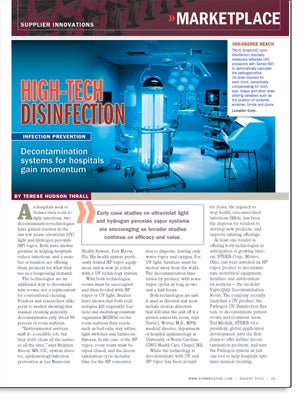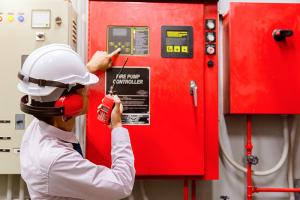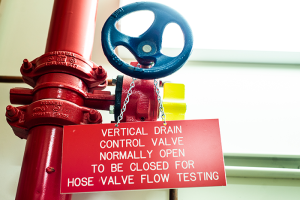High-tech disinfection

As hospitals seek to bolster their tools to fight infections, two decontamination technologies have gained traction in the last few years: ultraviolet (UV) light and hydrogen peroxide (HP) vapor. Both have shown promise in helping hospitals reduce infections, and a number of vendors are offering these products for what they see as a burgeoning demand.
The technologies are an additional way to decontaminate rooms, not a replacement for conventional cleaning. Vendors and researchers alike point to studies showing that manual cleaning generally decontaminates only about 50 percent of room surfaces.
"Environmental services staff do a credible job, but they don't clean all the surfaces all the time," says Stephen Streed, MS, CIC, system director, epidemiology/infection prevention at Lee Memorial Health System, Fort Myers, Fla. His health system previously trialed HP vapor equipment and is now in a trial with a UV technology system.
With both technologies, rooms must be unoccupied and then flooded with HP vapor or UV light. Studies have shown that both technologies kill vegetative bacteria and multidrug-resistant organisms (MDROs) on the room surfaces they reach, such as bed rails, tray tables, light switches and bathroom fixtures. In the case of the HP vapor, room vents must be taped closed; and the decontamination cycle includes time for the HP concentration to disperse, leaving only water vapor and oxygen. For UV light, furniture must be moved away from the walls. The decontamination time varies by product, with some vapor cycles as long as two and a half hours.
Both technologies are safe if used as directed and most include motion detectors that will shut the unit off if a person enters the room, says David J. Weber, M.D., MPH, medical director, department of hospital epidemiology at University of North Carolina (UNC) Health Care, Chapel Hill.
While the technology to decontaminate with UV and HP vapor has been around for years, the urgency to stop health care-associated infections (HAIs), has been the impetus for vendors to develop new products, and improve existing offerings.
At least one vendor is offering both technologies in anticipation of growing interest. STERIS Corp., Mentor, Ohio, last year unveiled an HP vapor product to decontaminate noncritical equipment, furniture and environmental surfaces — the modular VaproQuip Decontamination Room. The company recently launched a UV product, the Pathogon UV Disinfection System, to decontaminate patient rooms and treatment areas. Ted Mielnik, STERIS vice president, global application development, says the firm plans to offer further decontamination products, and sees the Pathogon system as just one tool to help hospitals optimize manual cleaning.
However, researchers say more evidence must be unearthed about both UV and HP vapor technologies' abilities to stop HAIs before infection control organizations would recommend the practice and a large number of hospitals would use them. One such researcher is William Rutala, Ph.D., MPH, and director of hospital epidemiology at UNC Health Care. "Just because a technology kills pathogens doesn't mean it reduces HAIs," he says. "It will only do this if the pathogens on these surfaces are important in the modes of transmission."
Research update
One peer-reviewed study addressing this question was published late last year, using the HP vapor technology from Bioquell Inc., Horsham, Pa. HP vapor technology was implemented on three units to decontaminate the rooms of patients known to be infected or colonized with MDROs, following their discharge. The study measured whether the next patient to be admitted acquired an MDRO. Compared with patients admitted to rooms that received standard cleaning only, patients in rooms that used the HP vapor technology were shown to be 64 percent less likely to acquire any MDRO. However, the findings for individual pathogens varied. While the patients admitted to the HP vapor-treated rooms were 80 percent less likely to acquire vancomycin-resistant enterococci (VRE), the risk of acquiring Clostridium difficile and methicillin-resistant Staphylococcus aureus (MRSA) dropped, but not significantly.
"Ultimately, researchers would like to show that these methods are cost-effective, or at least, which ones are the most cost-effective to use," says Rutala. "But you can't do that until you know the reductions each one of these technologies achieves."
Toward that end, Rutala and other researchers are working on a study to assess whether UV light technology will prevent infections. The 27-month study using the TRU-D Smart
UVC system manufactured by Lumalier Corp., Memphis, Tenn., is under way at nine hospitals. The study examines whether patients — those admitted to rooms in which the prior patient had colonization or infection due to MRSA, VRE or MDR Acinetobacter — have different rates of acquiring MDROs when their rooms have different cleaning protocols. Four different protocols will be used: standard disinfection with quaternary ammonium, enhanced disinfection with bleach, and each of those with the addition of the UVC technology. The results should be available in the fall of 2014.
A complication in assessing these technologies is that each brand of system is unique and should be tested separately, says Weber. He notes that the HP vapor solutions have different concentrations, while the UV products also have different features in their operation and equipment. For instance, the STERIS Pathogon UV system has a Windows-based remote-control tablet and software to allow selection of the cycle based on the dimensions of the area and the type of organism present in the room. In contrast, Lumalier's Tru-D product has a patented sensor technology, which analyzes the contents, shape, size and reflective properties of the room and automatically calculates a disinfection cycle time.
Figuring ROI
Without a preponderance of data, it can be difficult to determine the return on investment for these systems, which are relatively expensive, compared with other disinfection methods. Some of the UV and HP vapor decontamination machines can run close to $125,000, and monthly leasing costs run up to $4,000. However, vendors point out that HAIs are costly, too. "A postoperative MRSA infection could last three weeks or longer, with care costing $10,000 a week," notes John Barton, president
of Med Effect Inc., Orlando, Fla., whose company offers an HP mist product, the Sanosil Halo Fogger.
"We know the cost of health care infections," says Rutala, "and it wouldn't take eliminating many of them to make this equipment cost-effective. But we understand why hospitals wouldn't want to buy devices that are in the tens of thousands of dollars without proven benefit."
And it's not just the unreimbursed care on which hospitals take a financial hit, notes Mark Stibich, chief scientific officer at Xenex Healthcare Services, San Antonio. One customer of the UV light technology manufacturer prepared a business case to use the equipment. "Because HAIs increase length of stay for infected patients, they take beds away from profitable uses," notes Stibich. In this case, he adds, the customer found his hospital saved $2.3 million in six months because of fewer bed days lost due to MRSA infections.
Another possible savings could come from retaining packaged supply items that are normally discarded because they could carry pathogens after being placed in a patient's room. A May 2013 study using Bioquell's HP vapor system in rooms housing patients with MDROs, showed that none of the packaged items were contaminated after the treatment cycle. The study notes that using HP vapor this way could generate both financial savings and environmental benefits.
Assessing market penetration
Vendors report that a small but growing number of hospitals are using these systems. Most vendors interviewed had products at fewer than 100 hospitals, a small percentage of hospitals nationwide. Surprisingly, not all the hospitals are large. Med Effect's Barton notes that some of the firm's customers are 30- to 50-bed hospitals that use Sanosil for terminal cleaning in patient rooms. "With a 700-bed hospital, it's a different story," he says, adding that staff deploy HP vapor where it's critical to stop pathogens, such as isolation rooms, ICUs and operating suites.
Some Xenex customers are power users, says Stibich, scheduling the equipment to use it widely. Because staff cannot be in the room during cleaning, using the equipment takes coordination with housekeeping for the 5- to 20-minute cycles that Xenex equipment requires. For a typical power user, says Stibich, the system will be used from 11 a.m. to 6 p.m. for terminal cleaning in patient rooms. Late-night uses include operating suites and cardiac cath labs; then in early morning, units travel to infusion therapy rooms and equipment rooms. Such use can bring the cost down to $3 a room, says Stibich.
According to a 2011 article authored by Rutala and Weber, HP systems have been shown to do a better job at decontamination, performing more effectively at eliminating spore-forming organisms. However, UV systems generally can decontaminate more quickly.
It's this time element that is so vital in making the technologies practical and cost-effective for hospitals, says Streed. One example of a vendor's trying to lessen cycle time is Lumalier's new room paint, UVC360 Reflective Coating. In a May 2013 study in Infection Control and Hospital Epidemiology, the coating was found to decrease cycle time from 25 to five minutes for bacteria and from 43 to nine minutes for spores. "You can turn over the rooms quicker with reflective coating," says Chuck Dunn, president of Lumalier. "It's my hope that hospital architects and interior designers will start to think about the reflective properties of rooms."
While the data grow on the benefits and limitations of these technologies, momentum is building to scrutinize the role of the environment on infection prevention. Dunn notes that at the Society for Healthcare Epidemiology of America's decennial meeting in 2000, only two presentations on the agenda addressed how environments were playing into the spread of pathogens. Ten years later, there were 42 such presentations. "The impact of the disinfected environment is on the radar screen of these infection control experts," says Dunn, "and finding solutions to infection problems is a big deal."
Terese Hudson Thrall is a freelance writer in the Chicago area and a former associate editor for Health Facilities Management.
| Sidebar - Applying UV light in HVAC systems |
| Deploying ultraviolet germicidal irradiation (UVGI) to kill bacteria in health care facilities extends beyond the types of mobile units described in this feature. UVGI also is offered in applications for heating, ventilating and air conditioning systems. In HVAC applications, UVGI long has been touted for its ability to improve system efficiency. More recently, some manufacturers have been stressing the abilities of UVGI systems to drastically decrease microbial colonization in HVAC systems and, thereby, decrease the chances of airborne pathogens being spread around facilities. Microorganisms such as Pseudomonas, Klebsiella, Acinetobacter baumannii, Aspergillus and Staphlyococcus aureus are commonly isolated from HVAC system surfaces, notes Tim Leach, director of health care solutions for Steril-Aire Inc., Burbank, Calif., which offers UV lighting for use in HVAC systems. (Lumalier, American Ultraviolet, and other vendors also offer UV systems for HVAC.) Microorganisms, during their reproductive process, attach themselves to HVAC surfaces such as condensate cooling coils — forming a biofilm. As this biofilm forms on the coils, the interstitial space between the coil fins becomes narrow, causing the airflow velocity to increase beyond design conditions, Leach explains. Increased coil velocity then leads to poor heat exchange efficiency and moisture carryover. Leach further explains that the moisture carryover, combined with the reservoir of microorganisms proliferating on the coils, turns the HVAC system into the largest aerosol generator of pathogenic microbes in a health care setting. Chemically or mechanically removing the bioburden initially will help the HVAC system to run more efficiently, but this provides only a temporary fix. Since bacteria can double every 20 minutes, it is a matter of only a few days before the biofilm will grow back. If UV light is used within the system at sufficient concentration, its proponents argue, it will destroy the biofilm and will kill many pathogens that are leading contributors to health care-associated infections. No large, multicenter, randomized studies have been done on the benefits of UV light within HVAC systems. Leach, however, points to a 2011 study in the Journal of Perinatology by R.M. Ryan, G.E. Wilding, et al., that explored the application of UVGI within a neonatal intensive care unit (NICU) at the Women & Children's Hospital of Buffalo. The hypothesis was that the germicidal effect of UV light applied to the central coil components of two NICU HVAC units would decrease pathogens in the air and on surfaces, and thus decrease tracheal colonization in intubated NICU patients. The researchers further hypothesized that this would decrease ventilator-associated pneumonia (VAP) prevalent in smaller premature intubated patients. The study, which took more than two years to complete, found a greater than five-log reduction (-99.999 percent) in microbial load per square centimeter of HVAC coil in six days. The hospital also was able to reduce VAP among a very select part of the patient population by more than 50 percent, Leach says. During the study, no housekeeping, maintenance or clinical practices changed in the unit. Although UVGI in HVAC applications is a complex subject that requires far greater space than is available here, it is noted as another potential means of helping to reduce the spread of multidrug-resistant organisms that currently is being evaluated in the field. |
| Sidebar - For more information |
| For further information about the systems discussed in this month's "Marketplace" article, readers can contact the following vendors: » Bioquell Inc. » Lumalier Corp. » Med Effect Inc. » STERIS Corp. » Xenex Healthcare Services |




